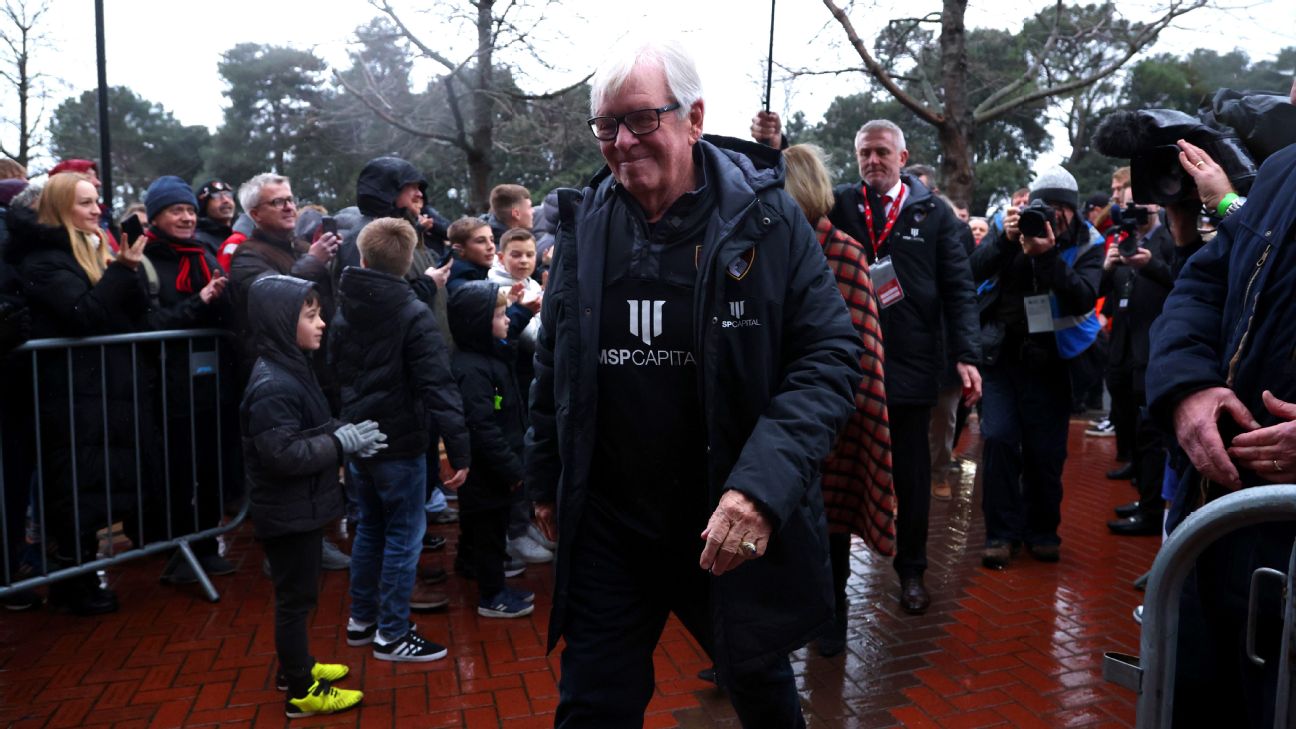Could American owners push the Premier League to be more like the profitable NFL?

With Vegas Golden Knights owner Bill Foley acquiring AFC Bournemouth last month, the number of American-owned Premier League clubs now stands at eight of 20, including four of the so-called Big Six (Manchester United, Arsenal, Liverpool and Chelsea). And every time a Premier League club goes up for sale, a gaggle of U.S. billionaires and private-equity types pops up to kick the tires.
Chelsea were the most recent example back in the spring, when the bid process shortlisted offers from Boston Celtics co-owner Stephen Pagliuca, a consortium led by Los Angeles Dodgers owners Todd Boehly and Mark Walter, the Ricketts family (who own the Chicago Cubs) and another group that included Josh Harris and David Blitzer (who own the Philadelphia 76ers).
– Stream on ESPN+: LaLiga, Bundesliga, more (U.S.)
Most American owners — indeed, most foreign owners, who represent 75% of the Premier League — have done little thus far to rock the boat in terms of how the league does business. But with a changing sports and media landscape — and with the league making an operating profit in just two of the past 10 years according to Kieron O’Connor, who writes the Swiss Ramble newsletter on football finance — you wonder how long that will be the case. (Note that operating profit/loss is different than accounting profit, which includes player trading, i.e. the cost of acquiring players vs. the revenue from letting them go.)
And given that the Premier League’s shareholders are the 20 member clubs themselves, there is no question that they have the clout to make radical changes — such as introducing salary caps, reducing or abolishing relegation and changing revenue distribution — if they so choose.
Why might they choose to do so? Well, because conditions have changed and because this set of owners (not just the American ones) is different from the sort of folk who owned European clubs in the past.
Historically, teams were bankrolled by individuals or corporations who weren’t necessarily looking to make a bottom-line return. Many clubs ran at a break-even level, while those who made losses were OK with it because their owners got a return in other ways. Sometimes, they were simply rich super-fans akin to wealthy boosters in NCAA sports; sometimes they were businessmen looking to raise their profile or gain political clout.
None of the current U.S. ownership groups fit this profile, but still, they invested because conditions looked favorable. The rationale was simple: acquiring a Premier League club was relatively affordable, and that gave you a foothold the most popular league (one with a genuine global footprint) in the world’s most popular sport.
Many were convinced that with some U.S. commercial sports know-how, they could monetize the game more effectively and the league’s popularity would continue to grow, and heck, if it ever cracked the U.S. market in a meaningful way, you were set for a pay day. Plus, with money being cheap at the time — and with many of these investors sitting on piles of it — acquiring unique assets like a sports team (or a piece of art or real estate) was a natural hedge against inflation.
Things have changed a little bit. Money isn’t quite as cheap (interest rates have risen), the economy has taken a hit and folks are realizing there is no quick U.S. fix to boost revenue. (Well, most anyway…)
There are basically three criteria that may lead an ownership group (not a nation-state, who have other reasons) to acquire an asset. One is vanity/philanthropy/personal enjoyment (like the historical owners of football clubs), but that generally doesn’t apply here. Another is profitability and cash flow, but as O’Connor shows, Premier League clubs made operating losses of £1.4 billion ($1.7bn) in the eight years pre-pandemic (and a whopping £2.3bn — or $2.8bn — of losses in the two subsequent years that were impacted by COVID). The third is capital appreciation: what you make back when you sell the asset will be far more than it cost you, both to acquire it and to run it over the years (if you made operating losses).
That last factor seems to be the only one that still applies. Perhaps it’s driven by the fact that both Fenway Sports Group and the Glazers are open to selling all or part of their stakes in Liverpool and Manchester United at reported valuations of $3bn and $5bn to $7bn — several multiples more than what they paid for them. But as the fine print says, “Past performance is not an indicator of future results.” It’s not something you want to take for granted.
The main reason so many Premier League clubs continue to make operating losses is that wages and acquisition costs continue to rise each year, more than doubling from around £2bn ($2.4bn) to £4.8bn ($5.8bn) in a decade.
Another way to think about this — and to understand the losses — is to consider the percentage of revenue that goes on labor costs, i.e. the amount that is paid to players in salaries. In the NFL, it’s capped at 48% as a result of the collective bargaining agreement with the NFL Players Association (NFLPA). In the Premier League, just one of the 20 clubs (Tottenham, at 39%) was below that threshold in 2018-19, the last season before the coronavirus pandemic. Excluding the three newly promoted clubs that year, the league average stood at 65.6%.
And bear in mind that unlike in the NFL, where money doesn’t change hands when players change teams, in the Premier League you pay a transfer fee when you sign a player from another club. In that 2018-19 season, the Premier League’s net spend — the difference between the costs incurred to sign players and the revenues gained from sending them elsewhere — was a whopping $1.15bn … which is a lot more than the NFL’s figure of, well, zero.
Simply put, the quickest way to profitability is controlling your costs, a concept that’s very familiar to owners in U.S. sports, all of which have some version of a salary cap or luxury tax. It seems plausible that Premier League owners will push for something along those lines, most likely linking squad expenses (not just player salaries, but transfer spending, agent fees and coaching staff remuneration) to a percentage of revenue. Indeed, a comparable system already exists in Spain’s LaLiga and UEFA, the governing body of European football, is implementing new regulations for teams competing in continental tournaments like the Champions League that aim to cap squad expenses to 70% of revenue by 2025-26.
So the appetite for something like this is already out there, and you’d expect Premier League clubs — including those not involved in European competition — to follow suit in some way. Of course, limiting your spending increases your exposure to relegation, which can be financially disastrous.
Is it possible there might be a push to reduce the number of relegation spots? Why not? It’s the quickest, easiest way to increase the value of all Premier League clubs, especially the smaller ones.
Also, why stop there? Could we see more revenue sharing like in the NFL, where virtually all revenue other than corporate sponsorships, concessions and 60% of gross ticket sales is split evenly among the 32 teams? In the interest of parity and sustainability and with certain safeguards (such as no relegation), who knows?
The main argument against this model is that it might hamper English clubs in the Champions League — another problem that the NFL doesn’t have to worry about. And sure, if UEFA’s new regulations aren’t properly enforced or unworkable, it would hurt Premier League team’s performances in Europe. But even for clubs that qualify for Europe, revenue from UEFA competitions represents no more than 15-20% of the total. And it’s not as if English clubs would suddenly stagnate and disappear if they spent a lower proportion of revenue.
Don’t think it will ever happen? Maybe you’re right. When times are good, the cash keeps rolling in and club valuations continue to rise, maybe there’s no need for all this. But it’s worth remembering that the Premier League’s Big Six all signed up for the Super League, and that Liverpool and Manchester United were behind Project Big Picture. Both projects were abandoned amid public outcry and political pressure, but the willingness was there. And if they’re willing to lawyer up and face political pressure, all it takes is for 14 of the 20 Premier League clubs to rewrite the rulebook. And no, given the success and profitability of the NFL, it’s not just American owners who might look favourably on this.
Every single owner, regardless where they’re from, knows how things work across the pond and how successful the NFL and NBA are. Every single owner got where they are by knowing how to run a business. And not every owner is wedded to the long-standing pyramid model of the European game.

